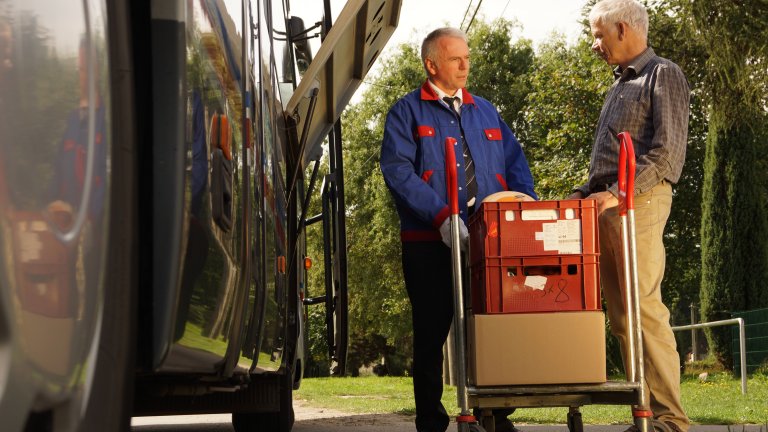
kombiBUS on its big tour
All great ideas start out small, for example as a simple “kombiBUS”. Five years ago it started to make its way from village to village in the Uckermark region. The kombiBUS is a public service vehicle just like any other, but there is a twist: upon request, it also transports freight for businesses which it picks up or drops off at the stops of its route. Passenger transport and freight transport under one bus roof. This generates additional revenue, which helps to ensure that local mobility in rural areas can be provided in the long-term.
Logistics businesses enter their available freight capacities into the system
The time has now come for the model undertaking known as LandLogistik, which started in the Uckermark region, to take a giant logistical step forward and, at the same time, to advance the state of Brandenburg:
“We are constructing a neutral mediation platform for the marketing of available, real and existing freight capacities in passenger and freight transport in the form of a combined transport chain,
At the Berlin-based consulting company Interlink Anja Sylvester had already been responsible for the kombiBUS and now she also manages the project LandLogistik.
At first glance, the aim of this project seems ridiculously easy to achieve – logistics businesses are supposed to enter their available capacities into a system – but in fact it is a task of Herculean proportions. In order for companies to be able to do so, all business processes must be fully digitalised. Furthermore, the vehicles of a company’s fleet have to be equipped with telematics. Because, if the idea is to be efficiently implemented, it is important to know the vehicles’ routes and possible stops with great precision. If their strict schedules allow it, new shipments may be picked up on the predetermined route.
Sylvester points out that studies conducted in the EU concluded that on average only about 72 per cent of the freight capacity of vehicles are being used. “So there’s still a lot that can be done,” Sylvester says. As to the advantages of the planned mediation platform, she puts it rather drastically: “It’s not necessary to use a huge truck to bring a carton of eggs to a village.” A large cargo’s “last mile” could be divided among other logistics partners. Strong partners could carry out the transport on that “last mile” of the route at lower costs or – from a quality management point of view – they could offer clients better services, e.g. deliveries to their doorstep.
The model undertaking LandLogistik, in which the farm cheese producer Wolters and the businesses Transinet GmbH and Fahrplangesellschaft B&B are involved and which will reach a project volume of altogether €1.2 million by the end of 2018, is being supported by the “European innovation partnership EIP” to an extent of 50%. The money will be used to develop a standardised information and mediation software.
LandLogistik can work at the state level as well as across Germany and Europe
Nearly every logistician uses his or her own digital operational system. Now it is crucial to transfer all the information to the neutral mediation platform and make it transparent. Besides the business’s profile, each vehicle will have its own accessible profile. “And here’s what’s special: the building block kombiBUS is now being put in place within a larger system,” explains Juliane Reimer, Project Manager at the Cluster Transport, Mobility and Logistics, which actively supports the undertaking jointly with the Cluster Food Industry. Reimer said that the combination of digitisation and food logistics was what made the project “especially exciting”. Sylvester added that as soon as
LandLogistik was available as a fully developed software solution there were no longer any obstacles standing in the way of its implementation throughout the state, Germany and Europe.